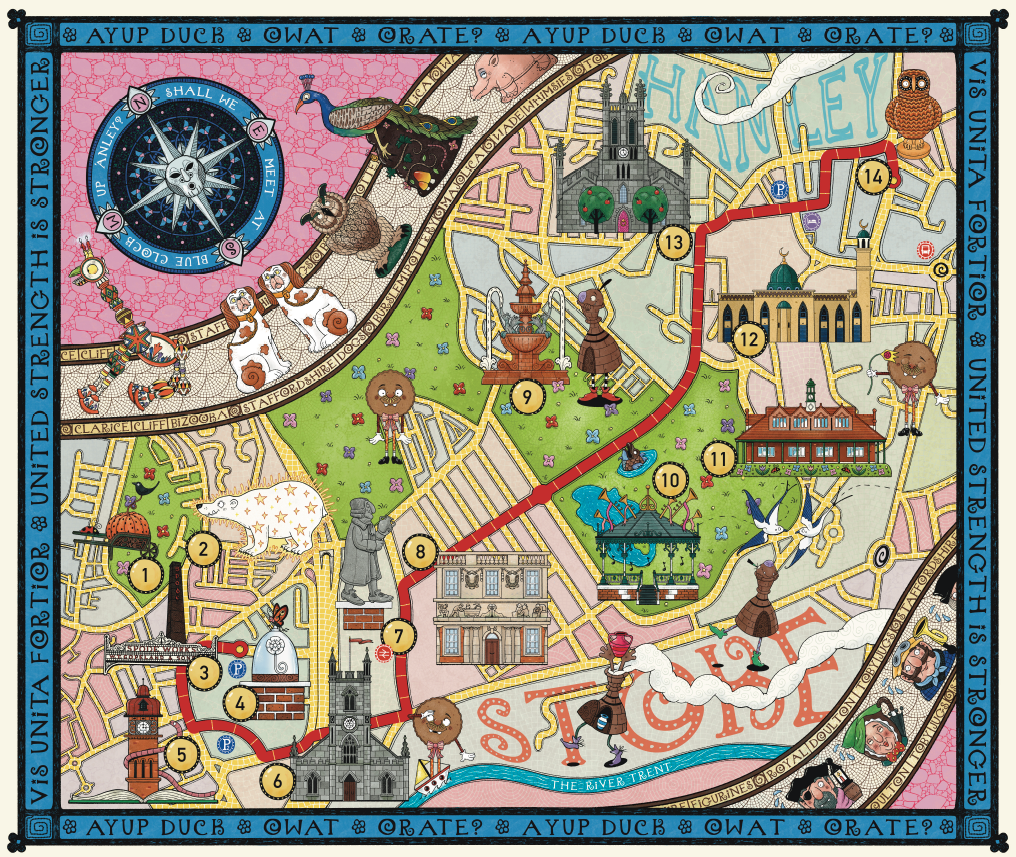Stoke-on-Trent Living Heritage City
Co-curating an inclusive narrative about our city’s culture and history along a new route launching April 2025.
Announcing the creation of the Living Heritage City App - an exciting new way to experience the cultural heritage and rich narratives of the city.
We’ve worked with partners and communities across the city to gather and share your stories, creating content that reflects and showcases our city’s rich and diverse heritage. In 2024, ‘Seed’ projects were commissioned to grow and develop this narrative around a theme, expanding the reach and impact of heritage engagement along the route.
A new map showcasing the recommended route to explore is below:

1. From the Spode carpark on Elenora Street, go left and continue left along Church Street. Passing Stoke Library on your right, you’ll see the churchyard across the junction.
2.Turn left and walk alongside (or through) the Minster churchyard. As you go round the corner past the Civic Centre, you’ll need to cross at the lights and walk across the bridge over the A500.
3. You’ll pass over the canal and under the railway. Then turn left onto Station Road and walk towards the station. Cross at the crossing by the station and continue along the road.
4. At the mini roundabout, turn right onto College Road and walk past Staffordshire University. Beresford Street is the fourth street you will cross.
5. Continue up College Road with Hanley Park on your right. If you walk through the park, you’ll need to exit back onto College Road.
6. At the corner of the park where College Road turns into Cleveland Road, stay left and continue to the end of College Road.
7. At the end of College Road with St. Mark’s Church on your left, turn right and along the main road, keeping right and walking towards the Hilton Hotel. Cross at the crossing take a left towards City Central Library. Turn right up Broad Street towards the entrance to the Potteries Museum & Art Gallery which is around the corner to the right, on Bethesda St.
Access guidance for has been created by FRONTLINEdance who have a video guide and accessible audio description for a core section of the route from Spode Rose Garden to Hanley Park.
Explore andFeedback
- A site of pottery production since at least 1756, this site was under the direct control of the Spode family between 1776 and 1833.
- Built between 1826 and 1830, the new Minster is surrounded by Anglo-Saxon and Medieval remains of the old churches on this land.
- Built in the 19th Century, Stoke-on-Trent railway station and Winton Square are a key arrival point for people entering the city.
- Designed by Thomas Mawson and laid out in 1892-7 on land acquired from the Shelton Old Hall Estate. The focus of the main park was the Pavilion.
- Built in 1833 and designed to hold a congregation of 2,100, St. Mark’s Church is the largest in the city.
The Living Heritage City Trail Map is a taster of the UKSPF-funded Stoke-on-Trent: A Living Heritage City project (launching in April 2025) that will connect the archives and collections of our museums to buildings and communities in Stoke and Hanley. Additional funding has been secured in 2024 from Arts Council England’s National Lottery Project Grants to support the Living Heritage City ‘Seeds’ Programme.
Stoke-on-Trent City Council has been working in partnership with cultural and heritage organisations with links to local communities along the route and will consult and co-curate with users, organisations and partners to showcase the rich stories and significant heritage of the city. Thanks to Professor Neil Brownsword, and Stoke-on-Trent Libraries who curated content alongside:










Partner Locations for map collection:
Stoke Library
Spode Museum Trust Heritage Centre
Civic Centre
Potteries Museum & Art Gallery
Stoke-on-Trent City Archives
Hanley Park Community Hub



 to add an item to your Itinerary basket.
to add an item to your Itinerary basket.







